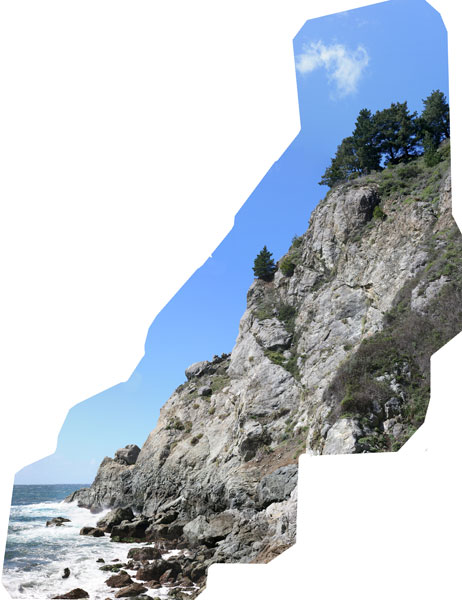After a lifetime of being an SF writer and rejader—and somewhat skittish about fantasy, I’m slowly coming to accept that my new novel, Jim and the Flims, is closer than ever to fantasy. [As of 2016, you browse a free online edition of Jim and the Flims via the book’s page.]
I’m attracted to fantasy just now as I’m tired of making up scientific explanations of things. I just want to go straight for the surrealism without having to incant the by-now-rather-stale rhetoric of quantum-this and dark-matter-that.
So now I’m getting interested in theories about what fantasy literature is and can become. (By the way, today’s illos are still from my trip to Big Sur last weekend.)

I just read a really interesting essay by my friend Farah Mendelsohn (as of 2016, it’s no longer free online), it’s the introduction to her critical volume Rhetorics of Fantasy, which I then proceeded to order a copy of from Amazon. So without having read the book yet, I’ll irresponsibly start outgassing about Farah’s ideas based on what I gleaned from the intro. She distinguishes several modes of fantasy:

Portal-quest. There’s a magic door to another word. The main characters go through, learn about the other world, get to know it well enough to achieve something, and then come back. Things from the other world don’t come through the portal to our world.
Immersive and Intrusive. In the immersive mode, the book simply starts out and is set in some fantastic other world. In the intrusive mode, creatures from another world appear in ours. The mood for intrusive fantasy is one of shock and amazement, what Farah Mendelsohn calls an “awestruck or skeptical tone.” She points out that it’s an effort to keep up this tone of surprise, and to this end, the oddness of the intruders often escalates over the book.
Liminal. Like the intrusive fantasy, the liminal fantasy is set in our world, but there the fantastic elements are fleeting, barely glimpsed. Maybe you see an elf in your back yard, rather than a giant were-pig rampaging down Wall Street. Or a little birdie talks to you. Mendelsohn suggests that in the liminal fantasy tales, the characters don’t get all worked up about the odd things, they take them as a normal part of life. This would set liminal fantasy apart from to intrusive fantasy.

It always surprises me to find such simple archetypal forms underlying such seemingly open-ended forms as fiction in general and fantasy and science fiction in particular. We stick to a few patterns that work—patterns perhaps suggested by basic aspects of our innate psychology.
How do Farah’s modes apply to my plans for Jim and the Flims?

I found I was almost viscerally compelled to put a portal into Jim and the Flims. I was floundering, and the notion of the portal was like a life-preserver to grab.
With a portal, you’re setting several things in play. One is that you have an alternate world. A second is that there will be limited access to the portal, that is, only a few characters can go through it. A third is that finding the homeward portal from the other world may take some effort. A fourth is that the portal can lead aliens to our world as well as leading us to theirs.
In Postsingular and Hylozoic, I had an alternate world, but here the “portal” wasn’t a specific location, but rather a certain meditative technique—akin to a magic spell. And in Mathematicians in Love, I had a certain device that would turn some region of space into a portal. You might think of it as a mechanized spell-caster.

[Merged panorama of a cliff at the end of a little-known and unmarked public path to the sea near milepost 38 and Partington Creek in Big Sur, a little north of Pfeiffer-Burns park. The entrance looks like a gated fire road.]
Of course SF is rife with portals—that’s often what faster-than-light travel devices look like: magic doors. But even a ship that you get inside and then get out of is a kind of portal, particularly if the ship makes a long trip very rapidly. The animated UFO that Frek rides in Frek and the Elixir serves as a portal.
The same portal issues arise with these variations: limited access to the portal, the difficulty of getting back home, and the two-way connection that the portal involves.

[Lucia Lodge, my favorite spot to stay in Big Sur, located some 30 miles south of the “town” of Big Sur.]
A far-future SF novel has the quality of an immersive fantasy novel—you’re in some place where everything is different, and you’re seeing through the eyes of a native, and slowly you get your bearings. The SF equivalent of intrusive fantasy is to introduce have the strange things intrude via a new invention. Or they might arrive as alien invaders.
Jim and the Flims is set in our present time, and it takes the form of an intrusive fantasy. That is, we start out in our familiar world, and the fantastic elements trickle in. Yes, there is a portal, but we first become aware of the portal because of some fantastic beings who’ve used the portal to intrude into our world.
Rather than continuing to escalate the oddity of the intruders, I plan to go the whole hog and have my characters go through the portal to the alternate world themselves. They get used to it pretty quickly, so we get more into the immersive than the intrusive mode, and they don’t have to act awestruck all the time.

Regarding liminal fantasy, I’ve often thought about a notion that there are other beings around us all the time, things we glimpse from the corners of our eyes. I guess this is a liminal fantasy concept. I like the notion that the world is full of living beings or spirits of place, akin to gnomes, elves and fairies. The story I wrote with Paul DiFilippo, “Elves of the Subdimensions,” is a liminal fantasy that turns intrusive, with, come to think of it, a kind of portal.
When starting Jim and the Flims I was thinking along these lines, imagining an alternate world the overlays and is wholly contiguous with ours. But now it seems less likely I’ll use that mode—probably it’s enough to be using the portal-quest and intrusive fantasy modes.
At least now, thanks to Farah, I have a clearer notion of what it is that I’m up to! Now I have to actually read some more of her book…
As mentioned above, as of 2016, you buy an ebook or paperback — or browse a free online edition — of Jim and the Flims via the book’s page. In the end, I backed off from total fantasy and ended up inventing SF-style “explanations” for all the bizarro surreal stuff in the book. But in any case, thinking in terms of fantasy was liberating. Visions first, explanations later!









March 25th, 2009 at 1:34 pm
I’m glad to hear you’re considering fantasy elements for your next book, I like your scientific explanations for stuff but I also like total fantasy books.
“Portal-quest: Things from the other world don’t come through the portal to our world.” OR DO THEY? *WINK* 😛
March 26th, 2009 at 12:07 am
I wonder if there is an SF equivalent to urban fantasy. Urban fantasy occurs in the modern world, only there is an alternate history that somehow injects fantasy elements into the modern world. The vampires, witches, faires, etc. all behave as if they have always been apart of the modern world. I guess the SF equivalent would involve involve injecting some fantastic style of tech into the past, maybe fully functioning AI discovered by Babbage. The story could discuss the history of AI as it changed hardware platforms: mechanical, fluid, vacuum, transistor. Despite the presence of AI, the story would be set in a world pretty much identical to our own. Then some conflict would arise from AI moving to biological computation. I suppose that is immersive and intrusive at the same time? The subtle joke of course is that fully functional AI would have absolutely no effect on mankind’s development.
March 27th, 2009 at 12:40 am
Philip Pullman fantasy – yes!
JK Rowling fantasy – no!
Yes, I’m a fantasy snob…
March 27th, 2009 at 1:03 pm
Rudy, I totally approve of you taking a whack at fantasy, with the caveat that we need your brand of math-flavored sf worse than we need another fantasy author. I also approve of Farah, a very intelligent and insightful person who would certainly advise Alex to try Diana Wynne-Jones instead of Rowling.
Grant, try THE GOBLIN RESERVATION by Simak – very similar to what you describe, but definitely hard sf.
The lines between all these genes are blurrier every day. Brian Aldiss suggested calling it all Speculative Fantasy. Tim Powers writes ‘magical realism’ novels that are, to me, hard to distinguish from fantasy and which contain science-fictional elements. Interesting to see what you will come up with! You ought to write a Quest fantasy novel; you’d be what the critics call ‘subversive’ to the genre.
March 28th, 2009 at 11:44 am
Steve, it’ll still be math-flavored SF…I’m just calling it fantasy because my science has gotten so far out that it seems like magic. A direction I was already heading in POSTSINGULAR and HYLOZOIC.
Writers often forget Clarke’s dictum that sufficently advanced tech seems like magic. I’d also add that it won’t even seem like tech, in that it won’t be using gears, or transistors, or chips. It’ll be all bio plus … other stuff. I like spacewarp zickzack hyperdimensional origami for the other other stuff.
And, yeah, a Kelly Freas green goblin is maybe a little TOO fantasy. I’m thinking now in terms of something a little odder. A voor, I might call it. It can change its shape like Plasticman because it’s a colony organism.
Grant, didn’t we work together at Autodesk? Hi. I saw a friend of yours at the EFF reading the other day.
March 28th, 2009 at 3:04 pm
Speaking of Clarke, a friend of mine recently stated, “Any technology distinguishable from magic is insufficiently advanced.” I’m sure he got that from someone else, but it’s a neat twist on Clarke’s dictum.
In a way, the Star Wars universe sort of operates this way. Clearly they are using technology, but there are a lot of things that seem like magic, particularly with regards to the Force. I would consider Star Wars to be sci-fantasy of the “immersive” type, with the Force being a “liminal” element for many of the characters.
Whether “magic” or “technology”, it seems the core feature is the ability to influence outcomes, usually through manipulation of the environment in some way.
When technology is so advanced, it’s mind-boggling and seemingly incomprehensible, there is almost a form of comfort that comes from it – sort of like a religious experience. You accept it without knowing the “how” because it is that compelling. Having the scientific explanation certainly satisfies the intellect and engages the imagination in a structured way, but leaving parts unexplained is not necessarily a bad thing (Clarke himself was masterful in this way).
I’m excited to see “Jim and the Flims” developing! Thanks for sharing your creative process!
April 26th, 2011 at 12:02 pm
Who says in science fiction you HAVE to explain the science? Fantasy is just a story played out on holodecks in the deep future. We need more deep future sci-fi, fantasy mashups….!
I mean did star trek every really explain how the holodeck worked?
Clarke had it right, future technology IS magic – so why not just write it as magic, get on with the story rather than having to explain it? I think it explains why star wars works it’s the magical “force” which is “fantasy” which makes it work.
April 26th, 2011 at 2:30 pm
Charlie Anders of io9 linked to this old post of mine in an article, “Why do so many former cyberpunk authors now write dark fantasy?” on April 16, 2011; the io9 piece has a few more quotes from me about fantasy vis-a-vis SF.
Meanwhile I finished writing Jim and the Flims and it’ll be out from Night Shade Books in June, 2011.
I put up a page for Jim and the Flims where you can look at my paintings for the book, and read my book-length writing notes as a free PDF — the notes include deeper levels of thought about the issues touched on here.